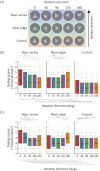Implied object direction from eye location enhances animacy ratings but not detection of chasing behavior
- PMID: 40596283
- PMCID: PMC12214860
- DOI: 10.1038/s41598-025-08681-0
Implied object direction from eye location enhances animacy ratings but not detection of chasing behavior
Abstract
Understanding how humans perceive animacy in dynamic visual stimuli is fundamental to elucidating the mechanisms underlying visual social cognition. While both object geometry and eye-like features are known to independently influence animacy impressions, their interactive effects remain insufficiently explored. This study investigates how the combination of object geometry and the location of eye-like patterns modulates the perception of animacy in non-living moving objects. In Experiment 1, we manipulated the pointing direction of triangular objects and the location of eye-like features (near the vertex, near the edge, or absent), and found that animacy impressions were enhanced when the direction of motion aligned with the gaze-implied object direction, irrespective of the object's geometrical shape. Experiment 2 examined whether this effect generalizes to an objective task, in which participants identify a target triangle chasing a green disk among distractors. Although the gaze-implied object direction did not significantly influence detection sensitivity, the spatial location of the eye pattern within the triangular shape continued to weakly modulate participants' performance. These findings suggest that cues related to eye location contribute to subjective animacy at multiple stages of cognitive processing, with their impact varying depending on task demands and perceptual context.
Keywords: Animacy; Eye location; Intention; Motion; Object shape; Wolfpack effect.
© 2025. The Author(s).
Conflict of interest statement
Declarations. Competing interests: Takahiro Kawabe is an employee of Nippon Telegraph and Telephone Corporation. Ethical approval: During the preparation of this work the author used ChatGPT 4o in order to improve English expression of text. After using this service, the author reviewed and edited the content as needed and take(s) full responsibility for the content of the publication.
Figures


Similar articles
-
The influence of a moving object's location on object identity judgments.J Exp Psychol Hum Percept Perform. 2025 Jun;51(6):764-780. doi: 10.1037/xhp0001311. Epub 2025 Mar 27. J Exp Psychol Hum Percept Perform. 2025. PMID: 40146595
-
The development of visual cognition: The emergence of spatial congruency bias.Dev Sci. 2024 Jul;27(4):e13482. doi: 10.1111/desc.13482. Epub 2024 Feb 8. Dev Sci. 2024. PMID: 38332650 Free PMC article.
-
The impact of noun animacy on the processing of L1 and L2 action metaphors among Chinese English learners: An event-related potential study.Medicine (Baltimore). 2025 Jun 27;104(26):e43036. doi: 10.1097/MD.0000000000043036. Medicine (Baltimore). 2025. PMID: 40587722 Free PMC article.
-
Systemic pharmacological treatments for chronic plaque psoriasis: a network meta-analysis.Cochrane Database Syst Rev. 2021 Apr 19;4(4):CD011535. doi: 10.1002/14651858.CD011535.pub4. Cochrane Database Syst Rev. 2021. Update in: Cochrane Database Syst Rev. 2022 May 23;5:CD011535. doi: 10.1002/14651858.CD011535.pub5. PMID: 33871055 Free PMC article. Updated.
-
Home treatment for mental health problems: a systematic review.Health Technol Assess. 2001;5(15):1-139. doi: 10.3310/hta5150. Health Technol Assess. 2001. PMID: 11532236
References
-
- Nishida, S., Kawabe, T., Sawayama, M. & Fukiage, T. Motion perception: from detection to interpretation. Annu. Rev. Vis. Sci.4, 501–523 (2018). - PubMed
-
- Troje, N. F. & Westhoff, C. The inversion effect in biological motion perception: evidence for a life detector?? Curr. Biol.16, 821–824 (2006). - PubMed
-
- Giese, M. A. & Poggio, T. Neural mechanisms for the recognition of biological movements. Nat. Rev. Neurosci.4, 179–192 (2003). - PubMed
MeSH terms
LinkOut - more resources
Full Text Sources

